Spinning “Lopi” Singles
Guest blogger Beth Abbott is here to share with us her experiences spinning “Lopi” style singles yarns and using them in her knitting. Follow along with her exploration of the history of these yarns and her efforts to engineer a way to spin them for herself.
———————————————————————————————-
When I started my study on Icelandic fleece, one of the first things I learned was that although traditionally the fleece had been separated into the two coats, thel (undercoat) and tog (long hairy outer coat), currently in Iceland, to my knowledge, there was/is no one spinning the coats separately. The two coats are now spun combined into several styles of singles yarns.
Lopi in History
In the late 1980’s there was “Lopi” under the brand name of Alafoss and a yarn that was mostly used in Iceland called “eingirni” meaning “singles”, a fine fairly firmly twisted yarn used in lace knitting. In early 2000 there were two more yarns added to the collection called Lett (light) Lopi (about half the diameter of the original Lopi) and a Heavy Lopi which was about twice the diameter of the regular Lopi. The company has undergone a reorganization and is now Istex.
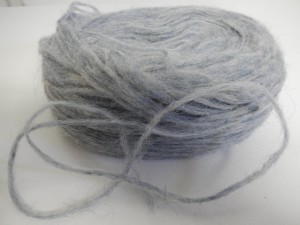
A lopi plate showing the size of the strand – note the lack of twist.
The word lopi means roving in Icelandic and the plötulopi plates that the Icelanders use for knitting their popular patterned yoked sweaters are actually just the last roving step in the process of spinning the fine “eingirni.” Usually three strands of this roving are worked together and the result is a very bulky but very light airy sweater, very warm, because the air is trapped in the yarn. The Lopi yarn was developed for the export market because they thought it would be easier for non-Icelanders to knit.
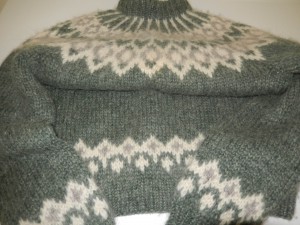
a hand knit sweater from real lopi plates
An interesting point is that those yoked sweaters have only been a tradition in Iceland since the 1920s, when a creative spinner decided to try to knit on her knitting machine with the rovings as they came from the mill, without spinning them. When she found this was possible, it opened up a whole new area of knitting for the hand knitter as well as the machine knitter.
Re-creating a Lopi style yarn
The original Lopi yarn has about one twist per inch and a twist angle of 15º. The diameter is about 8 – 10 wraps per inch. As many of you will know, it is difficult to spin a yarn this soft and thick consistently, and with some air to prevent it from being dense and heavy. I found that preparation was key to success in spinning a Lopi style yarn.
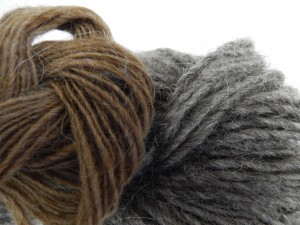
handspun Lett lopi and regular lopi style yarns
To prepare an Icelandic fleece: wash, dry and then carefully tease out the locks, paying special attention to the butt ends which tend to clump together during the washing. It is worth noting that the “thel” or undercoat is extremely fine and short and felts very easily, so that care is also needed in the washing process – NO playing with your hands – while the fleece is in the hot soapy water. Carefully lift the fleece from the slightly cooled water to empty the tub and fill with rinse water. Try to keep the temperature of the rinse water close to that of the slightly cooled wash water. Again – no movement while it is rinsing. Carefully lift out of the rinse water and either roll in a towel and dry flat or put in the washer on JUST SPIN – no rinsing process – to take out the excess water. Then lay flat on towels to dry. Once the fleece is dry, the teasing is fairly easy, though time consuming. However, the time spent in this part of the process will save time and agony later.
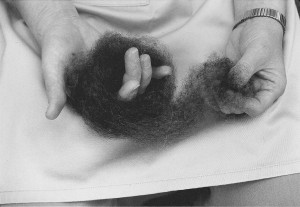 After carefully teasing out the locks I put them through my drum carder. I usually use a Louet drum carder for Icelandic as it has longer and finer teeth and will take the loft of the combined coats more successfully than many other carders. Usually I put the fleece through at least twice, splitting the first batt into two lengthwise and then putting each through again. I hold the batt up to the light and see if there are neps and lumps that need further carding.
After carefully teasing out the locks I put them through my drum carder. I usually use a Louet drum carder for Icelandic as it has longer and finer teeth and will take the loft of the combined coats more successfully than many other carders. Usually I put the fleece through at least twice, splitting the first batt into two lengthwise and then putting each through again. I hold the batt up to the light and see if there are neps and lumps that need further carding.
Once the fleece is well carded, I split the batt into narrow strips and predraft these into a sort of roving form. These I spin on a Louet wheel, because of its larger orifice and bobbins. Using the lowest bobbin/flyer ratio you have, work slowly to draft a bulky yarn, as consistent as possible. Any lumps often tend to drift to the outside of the yarn and can be picked off. Aim for one twist per inch. If need be, because you have only a high ratio wheel, you can put the yarn through the wheel again in the opposite direction to remove a little of the twist.
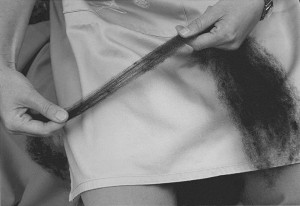
It is not easy for the hand spinner to create the roving style of Lopi but, by using my fingers to fan the fibres and letting the twist pick up the fibres, I am able to create a very light and airy, softly spun singles yarn. If I put in a little more twist, I can ply two strands together and get a Lopi diameter yarn that is airier than the original Lopi yarn, and one I like better.
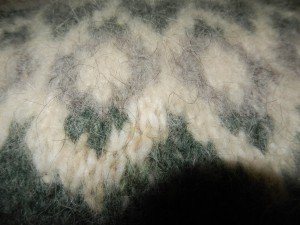
closeup of hand knit real lopi sweater – purchased in iceland – long hairy look is due to the long tog fibres in the yarn
The next time someone tells you that you must cut the fibres to be the same length for blending, or that fibres should be compatible for blending, remind them that the Icelandic fleece, with its strong outer coat like a long Lincoln and its fine under coat, more like the finest, shortest Merino, are regularly blended and spun in Iceland.
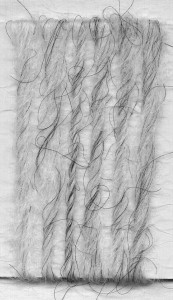
Beth Abbott has been spinning since 1975 and earned her Master Spinner Certificate from Georgian College, Owen Sound Ontario, in 1990. Her in-depth study is now in print as a book. Beth teaches in the Spinning Certificate Course at Haliburton School of Art on a regular basis. For more information on the Icelandic Fleece, consult her book “The Icelandic Fleece – a Fibre for All Reasons”. It is available from Beth and Ron Abbott – contact elizabethandronabbott@gmail.com

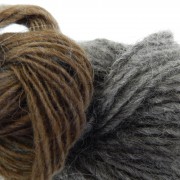


brilliant article, thank you – I will be linking to it everywhere as so many people are asking me about Icelandic, here is all the info 🙂
Icelandic fleece got on my radar with the article in the Worsted Issue about Viking sails… it got me day dreaming 🙂 that was a wonderful article.
Shortly after, the owner of our local mill gave me a 1/2 pound each of an Icelandic ram and lamb fleece. I spent a lot of time separating the tog and thel of the ram and carded and spun just the under coat. I saved the tog (very statiky) and combed it into nests to try the tog warp/thel weft. The yarn was a success, albeit the prep time was a lot. Imagining vikings helped this along.
As for your above described method, this is perfect for the lamb and I look forward to getting started. The lamb tog is much softer than the ram and the undercoat is almost silky. Question though… how did you finish and set your yarn? I would do a hot-cold-thwack-thwack style, making an effort to full the yarn – but this is only based on the Alafoss that I’ve seen which is alost felted. Maybe home spun should be finished more lightly?
Wonderfully informative. I’d love to take a class with Beth on this prep and spinning techniques.
Hi ANDREA
If you want a yarn more like the commercial lopi yarn, then you could use the shock method you describe, although Icelandic fibre fulls/felts very easily just in handling it. The real lopi roving the Icelanders use is very soft and flexible and has quite a different hand, so if you want that feel, then I would just leave it and let the fulling happen gradually as you work with it and wear it. If you don’t want it to change at all after you have knitted it, the go ahead and do the fulling first. Personally, for mitts etc, I like a little fulling to happen in the knitted fabric. I have never fulled Icelandic yarns because the fibre fulls so easily on its own. Sample, sample, sample to see what you really want. I would be happy to discuss the philosophy of fulling yarns further with you.
How exciting! Beth, I just purchased your book. It arrived this weekend.
In a fit a fine madness, I had bought several pounds of assorted Icelandic wool & discovered your book in my research.
Washed lotsb& getting ready to process & spin.
Thank you so much for sharing your knowledge.
Interesting article again 🙂 I see that you love what you do <3 Keep going
Hi. I went on a craze last year and bought 13 lbs of Icelandic fleece. I was a beginner spinner and could find next to no information online, even from experienced spinners. Now I know that spinning Lopi is a very exacting art. I’ve struggled with spinning it. (the same with churro, which is also double coated…and is used for Navajo rug weaving). So I am truly thankful for your article. A year later I better understand the process and though I have not yet mastered lopi, now with a little experience with other wools, I feel more confident. Thanks for your careful explanation. It helps.